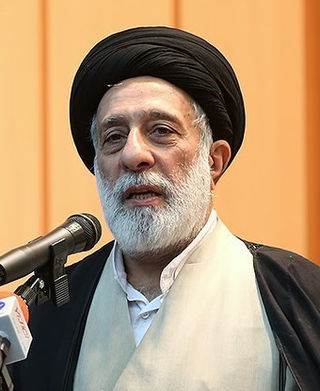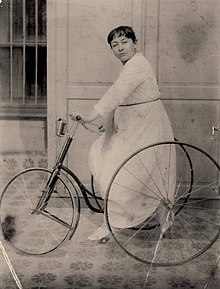A fatwā is a legal ruling on a point of Islamic law (sharia) given by a qualified Faqih in response to a question posed by a private individual, judge or government. A jurist issuing fatwas is called a mufti, and the act of issuing fatwas is called iftāʾ. Fatwas have played an important role throughout Islamic history, taking on new forms in the modern era.

Ayatollah Ruhollah Musavi Khomeini was an Iranian Islamic revolutionary, politician and religious leader who served as the first supreme leader of Iran from 1979 until his death. He was the founder of the Islamic Republic of Iran and the leader of the Iranian Revolution, which overthrew Mohammad Reza Pahlavi and ended the Iranian monarchy.

Seyyed Ali Hosseini Khamenei is an Iranian Twelver Shia marja' and politician who has been the second supreme leader of Iran since 1989. He previously served as third president of Iran from 1981 to 1989. Khamenei is the longest-serving head of state in the Middle East, as well as the second-longest-serving Iranian leader of the last century, after Shah Mohammad Reza Pahlavi.

Grand Ayatollah Hussein-Ali Montazeri was an Iranian Shia Islamic theologian, Islamic democracy advocate, writer and human rights activist. He was one of the leaders of the Iranian Revolution and one of the highest-ranking authorities in Shīʿite Islam. He was once the designated successor to the revolution's Supreme Leader, Ayatollah Khomeini, but they had a falling-out in 1989 over government policies that Montazeri claimed infringed on people's freedom and denied them their rights, especially after the 1988 mass execution of political prisoners. Montazeri spent his later years in Qom and remained politically influential in Iran, but was placed in house arrest in 1997 for questioning "the unaccountable rule exercised by the supreme leader", Ali Khamenei, who succeeded Khomeini in his stead. He was known as the most knowledgeable senior Islamic scholar in Iran and a grand marja of Shia Islam. Ayatollah Montazeri was said to be one of Khamenei's teachers.

Grand Ayatollah Mohammad Fazel Lankarani was an Iranian Twelver Shia Marja'. He was student of Grand Ayatollah Borujerdi. He was a child of a Persian mother and an Azerbaijani father.

Mohammad Reyshahri, also known as Mohammad Mohammadi-Nik, was an Iranian politician and cleric who was the first Minister of Intelligence, serving from 1984 to 1989 in the cabinet of Prime Minister Mir-Hossein Mousavi.

Sayyid Hadi Khamenei is an Iranian reformist politician, mujtahid and linguist. He is a key member of the reformist Association of Combatant Clerics, and a former deputy of the Majlis of Iran representing a district in Tehran.
The Cultural Revolution was a period following the Iranian Revolution, when the academia of Iran was purged of Western and non-Islamic influences, to align them with the revolutionary and political Islam. The cultural revolution sometimes involved violence in taking over the university campuses, as higher education in Iran had many secularist and leftist forces who were opposed to Ayatollah Khomeini's Islamic state in Iran. The official name used by the Islamic Republic is "Cultural Revolution".
The Guardianship of the Islamic Jurist is a concept in Twelver Shia Islamic law which holds that until the reappearance of the "infallible Imam", at least some of the "religious and social affairs" of the Muslim world should be administered by righteous Shi'i jurists (Faqīh). Shia disagree over whose "religious and social affairs" are to be administered and what those affairs are.
After the death of Muhammad in 632, a group of Muslims, who would come to be known as the Sunnis, believed that Muhammad's successor as caliph of the Islamic community should be Abu Bakr, whereas a second group of Muslims, who would come to be known as the Shias, believed that his successor should have been Ali. This dispute spread across various parts of the Muslim world, which eventually led to the Battle of Jamal and Battle of Siffin. Sectarianism based on this historic dispute intensified greatly after the Battle of Karbala, in which Husayn ibn Ali and some of his close partisans, including members and children of the household of prophet, were killed by the ruling Umayyad Caliph Yazid I, and the outcry for revenge divided the early Islamic community, albeit disproportionately, into two groups, the Sunni and the Shia. This is known today as the Islamic schism.

Khomeinism refers to the religious and political ideas of the leader of the 1979 Iranian Islamic Revolution, Ruhollah Khomeini. Khomeinism may also refer to the ideology of the clerical class which has ruled Islamic Republic of Iran founded by Khomeini, after his death. It can also be used to refer to the radicalization of segments of the Twelver Shia populations of Iran, Iraq, and Lebanon, and the Iranian government's recruitment of Shia minorities in Afghanistan, Pakistan, Saudi Arabia and Africa. The word Khomeinist and Khomeinists, derived from Khomeinism, are also used to describe members of Iran's clerical rulers and differentiate them from regular Shia Muslim clerics.
Muslim views on abortion are shaped by Hadith, as well as by the opinions of legal and religious scholars and commentators. The Quran does not directly address intentional abortion, leaving greater discretion to the laws of individual countries. Although opinions among Islamic scholars differ over when a pregnancy can be terminated, there are no explicit prohibitions on a woman's ability to abort under Islamic law.
Criticism of Twelver Shia Islam dates from the initial ideological rift among early Muslims that led to the two primary denominations of Islam, the Sunnis and the Shias. The question of succession to Muhammad in Islam, the nature of the Imamate, the status of the twelfth Shia Imam, and other areas in which Shia Islam differs from Sunni Islam have been criticized by Sunni scholars, even though there is no disagreement between the two sects regarding the centrality of the Quran, Muhammad, and many other doctrinal, theological and ritual matters. Shia commentators such as Musa al-Musawi and Ali Shariati have themselves, in their attempts to reform the faith, criticized practices and beliefs which have become prevalent in the Twelver Shia community.

The bicycle had a significant impact on the lives of women in a variety of areas. The greatest impact the bicycle had on the societal role of women occurred in the 1890s during the bicycle craze that swept American and European society. During this time, the primary achievement the bicycle gained for the women's movement was that it gave women a greater amount of social mobility. The feminist Annie Londonderry accomplished her around-the-globe bicycle trip as the first woman in this time. Due to the price and the various payment plans offered by American bicycle companies, the bicycle was affordable to the majority of people. However, the bicycle impacted upper and middle class white women the most. This transformed their role in society from remaining in the private or domestic sphere as caregivers, wives, and mothers to one of greater public appearance and involvement in the community. In the 21st century bicycling remains a contentious issue addressed by feminists in countries such as Saudi Arabia and Iran.

A fatwa by Ayatollah Ali Khamenei, the Supreme Leader of Iran, against the acquisition, development and use of nuclear weapons dates back to the mid-1990s. The first public announcement is reported to have occurred in October 2003, followed by an official statement at a meeting of the International Atomic Energy Agency (IAEA) in Vienna in August 2005.
Marja' is a title given to the highest level of Twelver Shia religious cleric, with the authority given by a hawzah to make legal decisions within the confines of Islamic law for followers and clerics below him in rank. The highest ranking marjiʿ is known as the marja al-mutlaq or marja al-taqlid al-mutlaq. A marji' is also, or usually is also, a grand ayatollah.

A Fatwa prohibiting the insulting of the most religious figures of Sunni Islam was published by Iran's Supreme Leader, Ali Khamenei, on 30 September 2010. The fatwa was issued following the insulting of Aisha by Yasser Al-Habib. This fatwa received various reactions from Shia and Sunni Muslims, and from Arabic and Western media.
The relationship between Islam and music has long been a complex and controversial matter. Many Muslims believe that the Qur'an and Sunnah prohibit music ; however, other Muslims disagree and believe that some forms of music are permitted. Despite this controversy, music has been popular and flourished at various times and places in the Islamic world, often in palaces and private homes to avoid censorship.

Cycling in Turkey is held back by poor infrastructure. It is sometimes done for health reasons, and infrastructure is being improved. The World Health Organization has called for transport in Turkey to include more active transport such as cycling.















